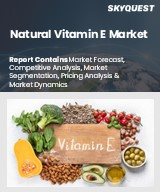
|
시장보고서
상품코드
1785634
천연 비타민 E 시장 규모, 점유율, 성장 분석, 제품 유형별, 공급원별, 유통 채널별, 지역별 - 산업 예측(2025-2032년)Natural Vitamin E Market Size, Share, and Growth Analysis, By Product Type (Tocopherols and Tocotrienols), By Source (Soybean Oil, Sunflower Oil), By Distribution Channel, By Region - Industry Forecast 2025-2032 |
||||||
천연 비타민 E 세계 시장 규모는 2023년 8억 9,000만 달러, 2024년 9억 7,000만 달러에서 2032년에는 17억 6,000만 달러로 성장하고, 예측 기간(2025년-2032년)에 CAGR 7.8%를 보일 전망입니다.
천연 성분에 대한 소비자의 선호도가 높아지면서 식품, 건강기능식품, 퍼스널케어 분야에서 천연 비타민 E에 대한 수요가 증가하고 있습니다. 항산화 효과와 만성 질환을 퇴치하는 영양소의 가능성에 대한 인식이 높아짐에 따라 제조업체들은 합성 대체품 대신 천연 유래 토코페롤과 토코트리에놀을 선택하게 되었습니다. 이러한 추세는 예방적 건강관리를 중시하는 북미와 유럽의 건강 지향과 고령화에서 특히 두드러집니다. 또한, 천연 성분을 우대하는 엄격한 규제 기준은 제품 표시의 투명성에 대한 소비자의 요구를 높이고 있습니다. 이러한 변화로 인해 제조업체들은 규정 준수를 보장하고 클린 라벨 인증을 받기 위해 천연 유래 비타민 E를 사용하도록 장려하고 있습니다. 그 결과, 천연 비타민 E는 기능성 영양식품 및 웰빙 제품에 필수적인 성분으로 부상하고 있습니다.
목차
서론
- 조사 목적
- 조사 범위
- 정의
조사 방법
- 정보 조달
- 2차와 1차 데이터 방법
- 시장 규모 예측
- 시장 전제조건과 제한
주요 요약
- 세계 시장 전망
- 공급과 수요 동향 분석
- 부문별 기회 분석
시장 역학과 전망
- 시장 개요
- 시장 규모
- 시장 역학
- 성장 촉진요인과 기회
- 성장 억제요인과 과제
- Porter의 Five Forces 분석
주요 시장 인사이트
- 중요 성공 요인
- 경쟁 정도
- 주요 투자 기회
- 시장 생태계
- 시장의 매력 지수(2024년)
- PESTEL 분석
- 거시경제 지표
- 밸류체인 분석
- 가격 분석
천연 비타민 E 시장 규모 : 제품 유형별&CAGR(2025년-2032년)
- 시장 개요
- 토코페롤
- 토코트리에놀
천연 비타민 E 시장 규모 : 공급원별&CAGR(2025년-2032년)
- 시장 개요
- 대두유
- 해바라기유
- 옥수수유
- 카놀라유
- 기타
천연 비타민 E 시장 규모 : 유통 채널별&CAGR(2025년-2032년)
- 시장 개요
- 온라인 소매
- 약국
- 슈퍼마켓
- 전문 건강식품점
천연 비타민 E 시장 규모&CAGR(2025년-2032년)
- 북미
- 미국
- 캐나다
- 유럽
- 독일
- 스페인
- 프랑스
- 영국
- 이탈리아
- 기타 유럽
- 아시아태평양
- 중국
- 인도
- 일본
- 한국
- 기타 아시아태평양
- 라틴아메리카
- 브라질
- 기타 라틴아메리카
- 중동 및 아프리카
- GCC 국가
- 남아프리카공화국
- 기타 중동 및 아프리카
경쟁 정보
- 주요 5개사 비교
- 주요 기업의 시장 포지셔닝(2024년)
- 주요 시장 기업이 채택한 전략
- 최근 시장 동향
- 기업의 시장 점유율 분석(2024년)
- 주요 기업 개요
- 기업 상세
- 제품 포트폴리오 분석
- 기업 부문별 점유율 분석
- 매출 전년대비 비교(2022년-2024년)
주요 기업 개요
- Archer Daniels Midland Company(ADM)(USA)
- BASF SE(Germany)
- Koninklijke DSM N.V(Netherlands/Switzerland)
- Davos Life Science(part of KLK OLEO)(Malaysia)
- Matrix Life Science Pvt. Ltd.(India)
- Kensing LLC(USA)
- BTSA Biotecnologias Aplicadas SL(Spain)
- Excel Vite Inc.(Malaysia/USA)
- Parchem fine & specialty chemicals(USA)
- Orah Nutrichem Pvt. Ltd.(India)
- Healthful International Co., Ltd.(HSF)(China)
- Organic Technologies(USA)
- Vasu Pharmatech Pvt. Ltd.(India)
- Vasudha Chemicals Pvt Ltd(India)
- Indena S.p.A.(Italy)
- Nutraceutix(USA)
- AstaReal Group(Japan)
- BASF Human Nutrition(Germany)
- ADM Animal Nutrition(USA)
- DSM Nutritional Products(Netherlands/Switzerland)
결론과 제안
LSH 25.08.13Global Natural Vitamin E Market size was valued at USD 890 Million in 2023 poised to grow from USD 970 Million in 2024 to USD 1760 Million by 2032, growing at a CAGR of 7.8% in the forecast period (2025-2032).
The rising consumer preference for natural ingredients is propelling demand for natural vitamin E across the food, dietary supplement, and personal care sectors. As awareness of the antioxidant benefits and the potential of nutrients to combat chronic diseases grows, manufacturers increasingly opt for naturally sourced tocopherols and tocotrienols instead of synthetic alternatives. This trend is particularly prominent among health-focused and aging populations in North America and Europe, emphasizing preventive healthcare. Furthermore, stringent regulatory standards favoring natural ingredients have amplified consumer demand for transparency in product labeling. This shift encourages manufacturers to adopt naturally sourced vitamin E to ensure compliance and achieve clean label certification. As a result, natural vitamin E emerges as a vital component in functional nutrition and wellness products.
Top-down and bottom-up approaches were used to estimate and validate the size of the Global Natural Vitamin E market and to estimate the size of various other dependent submarkets. The research methodology used to estimate the market size includes the following details: The key players in the market were identified through secondary research, and their market shares in the respective regions were determined through primary and secondary research. This entire procedure includes the study of the annual and financial reports of the top market players and extensive interviews for key insights from industry leaders such as CEOs, VPs, directors, and marketing executives. All percentage shares split, and breakdowns were determined using secondary sources and verified through Primary sources. All possible parameters that affect the markets covered in this research study have been accounted for, viewed in extensive detail, verified through primary research, and analyzed to get the final quantitative and qualitative data.
Global Natural Vitamin E Market Segments Analysis
The global natural vitamin E market is segmented based on product type, source, distribution channel, and region. In terms of product type, the market is categorized into tocopherols and tocotrienols. Based on source, the market is divided into soybean oil, sunflower oil, corn oil, canola oil, and others. In terms of distribution channel, the market is classified into online retail, pharmacies, supermarkets, and specialty health stores. Based on region, the market is segmented into North America, Europe, Asia-Pacific, Central & South America, and the Middle East & Africa.
Driver of the Global Natural Vitamin E Market
The surge in consumer interest toward preventive healthcare, immune support, and clean-label options is a key factor propelling the demand for natural vitamin E products. Increasing recognition of the antioxidant and anti-inflammatory benefits associated with natural vitamin E is enhancing its adoption across various sectors, including dietary supplements, functional foods, and personal care items. This rising trend is notably seen among older demographics and urban consumers who are actively pursuing plant-based wellness solutions. As a result, natural vitamin E is becoming an essential ingredient, driving growth and innovation within these industries.
Restraints in the Global Natural Vitamin E Market
The global market for natural vitamin E faces significant challenges due to the complex extraction and purification processes involved, which tend to escalate production costs in comparison to synthetic alternatives. This market is further constrained by the volatility of the supply chain, influenced by agricultural conditions and geopolitical events, given its dependence on specific crops like sunflowers and soybeans. As a result, the limited availability of raw materials creates a cost barrier that hampers pricing competitiveness, particularly in markets that are sensitive to price variations. Consequently, these factors restrict the overall penetration and growth of the natural vitamin E market worldwide.
Market Trends of the Global Natural Vitamin E Market
The Global Natural Vitamin E market is witnessing a significant trend towards the integration of artificial intelligence (AI) and personalized nutrition platforms, revolutionizing how consumers approach supplementation. Companies are increasingly leveraging AI to enhance formulation precision and deliver customized vitamin E blends that cater to individual health needs, lifestyles, and age considerations. This shift not only fosters greater consumer engagement but also aligns with the growing demand for personalized health solutions. As a result, the market is evolving towards a model that emphasizes tailored wellness interventions, ensuring that consumers receive the most effective and relevant dietary support in their pursuit of optimal health.
Table of Contents
Introduction
- Objectives of the Study
- Scope of the Report
- Definitions
Research Methodology
- Information Procurement
- Secondary & Primary Data Methods
- Market Size Estimation
- Market Assumptions & Limitations
Executive Summary
- Global Market Outlook
- Supply & Demand Trend Analysis
- Segmental Opportunity Analysis
Market Dynamics & Outlook
- Market Overview
- Market Size
- Market Dynamics
- Drivers & Opportunities
- Restraints & Challenges
- Porters Analysis
- Competitive rivalry
- Threat of substitute
- Bargaining power of buyers
- Threat of new entrants
- Bargaining power of suppliers
Key Market Insights
- Key Success Factors
- Degree of Competition
- Top Investment Pockets
- Market Ecosystem
- Market Attractiveness Index, 2024
- PESTEL Analysis
- Macro-Economic Indicators
- Value Chain Analysis
- Pricing Analysis
Global Natural Vitamin E Market Size by Product Type & CAGR (2025-2032)
- Market Overview
- Tocopherols
- Tocotrienols
Global Natural Vitamin E Market Size by Source & CAGR (2025-2032)
- Market Overview
- Soybean Oil
- Sunflower Oil
- Corn Oil
- Canola Oil
- Others
Global Natural Vitamin E Market Size by Distribution Channel & CAGR (2025-2032)
- Market Overview
- Online Retail
- Pharmacies
- Supermarkets
- Specialty Health Stores
Global Natural Vitamin E Market Size & CAGR (2025-2032)
- North America (Product Type, Source, Distribution Channel)
- US
- Canada
- Europe (Product Type, Source, Distribution Channel)
- Germany
- Spain
- France
- UK
- Italy
- Rest of Europe
- Asia Pacific (Product Type, Source, Distribution Channel)
- China
- India
- Japan
- South Korea
- Rest of Asia-Pacific
- Latin America (Product Type, Source, Distribution Channel)
- Brazil
- Rest of Latin America
- Middle East & Africa (Product Type, Source, Distribution Channel)
- GCC Countries
- South Africa
- Rest of Middle East & Africa
Competitive Intelligence
- Top 5 Player Comparison
- Market Positioning of Key Players, 2024
- Strategies Adopted by Key Market Players
- Recent Developments in the Market
- Company Market Share Analysis, 2024
- Company Profiles of All Key Players
- Company Details
- Product Portfolio Analysis
- Company's Segmental Share Analysis
- Revenue Y-O-Y Comparison (2022-2024)
Key Company Profiles
- Archer Daniels Midland Company (ADM) (USA)
- Company Overview
- Business Segment Overview
- Financial Updates
- Key Developments
- BASF SE (Germany)
- Company Overview
- Business Segment Overview
- Financial Updates
- Key Developments
- Koninklijke DSM N.V (Netherlands/Switzerland)
- Company Overview
- Business Segment Overview
- Financial Updates
- Key Developments
- Davos Life Science (part of KLK OLEO) (Malaysia)
- Company Overview
- Business Segment Overview
- Financial Updates
- Key Developments
- Matrix Life Science Pvt. Ltd. (India)
- Company Overview
- Business Segment Overview
- Financial Updates
- Key Developments
- Kensing LLC (USA)
- Company Overview
- Business Segment Overview
- Financial Updates
- Key Developments
- BTSA Biotecnologias Aplicadas SL (Spain)
- Company Overview
- Business Segment Overview
- Financial Updates
- Key Developments
- Excel Vite Inc. (Malaysia/USA)
- Company Overview
- Business Segment Overview
- Financial Updates
- Key Developments
- Parchem fine & specialty chemicals (USA)
- Company Overview
- Business Segment Overview
- Financial Updates
- Key Developments
- Orah Nutrichem Pvt. Ltd. (India)
- Company Overview
- Business Segment Overview
- Financial Updates
- Key Developments
- Healthful International Co., Ltd. (HSF) (China)
- Company Overview
- Business Segment Overview
- Financial Updates
- Key Developments
- Organic Technologies (USA)
- Company Overview
- Business Segment Overview
- Financial Updates
- Key Developments
- Vasu Pharmatech Pvt. Ltd. (India)
- Company Overview
- Business Segment Overview
- Financial Updates
- Key Developments
- Vasudha Chemicals Pvt Ltd (India)
- Company Overview
- Business Segment Overview
- Financial Updates
- Key Developments
- Indena S.p.A. (Italy)
- Company Overview
- Business Segment Overview
- Financial Updates
- Key Developments
- Nutraceutix (USA)
- Company Overview
- Business Segment Overview
- Financial Updates
- Key Developments
- AstaReal Group (Japan)
- Company Overview
- Business Segment Overview
- Financial Updates
- Key Developments
- BASF Human Nutrition (Germany)
- Company Overview
- Business Segment Overview
- Financial Updates
- Key Developments
- ADM Animal Nutrition (USA)
- Company Overview
- Business Segment Overview
- Financial Updates
- Key Developments
- DSM Nutritional Products (Netherlands/Switzerland)
- Company Overview
- Business Segment Overview
- Financial Updates
- Key Developments















